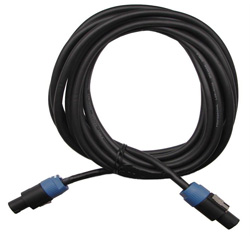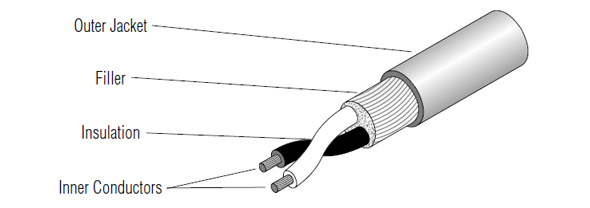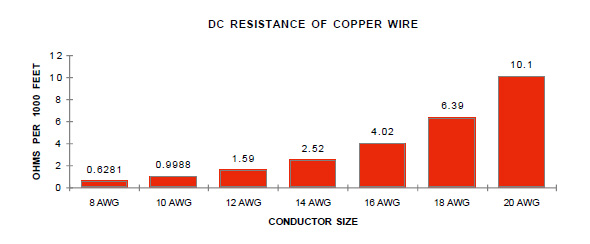See Part 1, Microphone Cable, here.
What are the main parts of a loudspeaker cable, and what does each one do?
Typically a loudspeaker cable has two stranded copper conductors, covered with insulation, twisted together with fillers and sheathed with an overall jacket.
How big should the conductors be?
The required size (or gauge) of the conductors depends on three factors: (1) the load impedance; (2) the length of cable required; and (3) the amount of power loss that can be tolerated. Each of these involves relationships between voltage (volts), resistance (ohms), current (amperes) and power (watts). These relationships are defined with Ohm’s Law.
The job of a loudspeaker cable is to move a substantial amount of electrical current from the output of a power amplifier to a loudspeaker system. Current flow is measure in amperes. Unlike instrument and microphone cables, which typically carry currents of only a few milliamperes (thousandths of an ampere), the current required to drive a speaker is much higher; for instance, an 8-ohm speaker driven with a 100-watt amplifier will pull about 3-1/2 amperes of current.
By comparison, a 600-ohm input driven by a line-level output only pulls about 2 milliamps. The amplifier’s output voltage, divided by the load impedance (in ohms), determines the amount of current “pulled” by the load. Resistance limits current flow, and decreasing it increases current flow. If the amplifier’s output voltage remains constant, it will deliver twice as much current to an 8-ohm load as it will to a 16-ohm load, and four times as much to a 4-ohm load. Halving the load impedance doubles the load current.
For instance, two 8-ohm loudspeakers in parallel will draw twice the current of one loudspeaker because the parallel connection reduces the load impedance to 4 ohms.
(For simplicity’s sake we are using the terms resistance and impedance interchangeably; in practice, a loudspeaker whose nominal impedance is 8 ohms may have a voice coil DC resistance of about 5 ohms and an AC impedance curve that ranges from 5 ohms to 100 ohms, depending on the frequency, type of enclosure, and the acoustical loading of its environment.)
How does current draw affect the conductor requirements of the loudspeaker cable?
A simple fact to remember: Current needs copper, voltage needs insulation. To make an analogy, if electrons were water, voltage would be the “pressure” in the system, while current would be the amount of water flowing. You have water pressure even with the faucet closed and no water flowing; similarly, you have voltage regardless of whether you have current flowing.
Current flow is literally electrons moving between two points at differing electrical potentials, so the more electrons you need to move, the larger the conductors (our “electron pipe”) must be. In the AWG (American Wire Gauge) system, conductor area doubles with each reduction of three in AWG; a 13 AWG conductor has twice the copper of a 16 AWG conductor, a 10 AWG twice the copper of a 13 AWG, and so on.

















